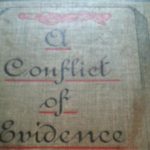Happy Birthday, Sir Arthur Conan Doyle!
Detective fiction from the Partner Collections
by Melanie J. Meyers, M.S., Senior Reference Librarian, Center for Jewish History
“My name is Sherlock Holmes. It is my business to know what other people don’t know.” –from “The Casebook of Sherlock Holmes” (1892)
May 22, 1859 was the birthday of Sir Arthur Conan Doyle, creator of Sherlock Holmes: the most celebrated sleuth in the canon of detective fiction. Holmes, one of the most enduring characters in literature, was exceptionally popular during the late 19th and early 20th centuries, and was serialized in many publications. Members of the Yiddish-speaking world were also fans of the great detective, and the YIVO Institute for Jewish Research here at the Center holds several Yiddish versions of Sherlockian adventures in both short story compilations and serial versions.
As the Holmes stories were often printed in periodical form first, the compilations subsequently published in places such as Warsaw were not always the same as the “official” versions. Their titles, for example, present differences. YIVO holds a book by the title of Fantasy and Reality (Warsaw: 1926), which is five of the stories from The Adventures of Sherlock Holmes. One of the stories included was “The Adventure of the Engineer’s Thumb,” or, as the Yiddish version was called (in translation), “The Case of the Master Builder.” YIVO also holds a copy of a Holmes story from a Yiddish periodical (publication date unknown), which is curiously titled “Holmes and the Circus” and has art depicting a sinister-looking big-top scene. It appears to be the story that Doyle titled “The Adventure of the Veiled Lodger,” as that is the Holmes tale in which a circus theme features prominently.
As usual, there is more to be learned from looking at these items than the fact that there was a demand for Sherlock Holmes stories among Yiddish-speakers. One of the Holmes short story translations, which was simply titled “An Interesting Study of Exceptional Human Ability,” was published right here in New York in 1928. At the end of the book, there is a detailed list of other works available in Yiddish from the same publisher, including translations of Tolstoy and Zola, and books on palm reading, hypnotism and dream interpretation. Most books were available for 5-10 cents (although Tolstoy and Zola were slightly more expensive, at 20 cents a book). The implication is that the Yiddish-speaking population in New York City was hungry for reading material in their own language—enough to have their own local printing company to cater to their tastes.
In addition to the Holmes materials held by YIVO, there is a large cross-section of Jewish detective fiction held by other Center for Jewish History partners. American Sephardi Federation holds mysteries by Caroline Roe, who wrote a very well-received series featuring protagonist Issac of Girona, a 14th-century Jewish physician at the Spanish court who has a knack for healing patients and solving crimes. American Jewish Historical Society holds many American detective series with Jewish protagonists, such as Faye Kellerman’s best-selling series about husband and wife crime-solvers Peter Decker and Rina Lazarus. And of course, Harry Kemelman’s beloved Rabbi Small series is held by AJHS—including the first installment of the series, Friday, the Rabbi Slept Late, which won the Edgar Award for Best First Mystery in 1965. The collections also hold authors such as Maan Meyers, Kinky Friedman, Batya Gur and Michael Chabon. And AJHS’s Soble Rare Book Collection also has a lovely copy of the first book written by the first Jewish American author of crime fiction. The book is titled A Conflict of Evidence and was written by Rodrigues Ottolengui in 1893. Ottolengui was of Sephardic descent, and went on to write additional books of crime fiction. The fourth book he wrote, Final Proof, was selected by mystery master Ellery Queen as a “Queen’s Quorum” selection, which was high praise for a mystery writer of that time.
“I had no idea that such individuals exist outside of stories.”
–Dr. Watson, from "A Study in Scarlet" (1887).
Conduct your own investigation of the collections by clicking here.
Above Image: A Conflict of Evidence by Rodrigues Ottolengui (1893).
c/o American Jewish Historical Society

